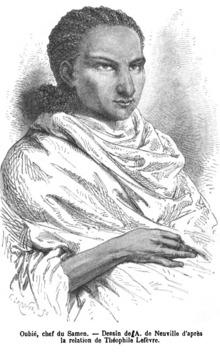Wube Haile Maryam
Wube Haile Maryam, also called Wube Haile Mariam or Dejazmach Wube, (1799–1867)[1] was a regional ruler and dejazmach in Tigray, Simien, and other coastal territories, in an area that is now part of northern Ethiopia and central Eritrea.[2]:549[3]:39 Wube is remembered in Eritrea for barbarous military raids.[2]:549[3]:39 He was defeated and imprisoned in 1855 by Kassa Hailu. Some sources date Wube's defeat as the end of Ethiopia's Zemene Mesafint era.[4]:64[5]:241

Dejazmach
Wube was born in 1800.[2]:549[6] He is variably reported as having become the regional chief of Simien upon the death of his father Dejazmach Haile Maryam in 1826,[6] or as having ruled from 1831.[2]:549 He was a persistent warlord, who leveraged his governorship of the district of Wogera into a wider rule of Simien and Tigray.[7] Considered one of the more powerful of numerous concurrently feuding regional warlords,[7]:93 Wube is recognized as having had ambitions on becoming emperor himself,[7] and he arranged for completion of the ongoing building of Dirasge Mariam Church for his coronation.[6][8] His status is underpinned by his being exempted from the usual requirement of vassals to attend the court of Ras Ali II, regent to the Emperor of Ethiopia.[7]
In 1841, at Wube's request, the See of Alexandria sent Abuna Salama III to become the new patriarch of the Ethiopian Orthodox Church.[6] That same year, Wube defeated Ras Ali II in battle, taking Gondar, the then capital of Ethiopia.[9]:301 Nonetheless, Ras Ali II escaped. In February 1842, their armies clashed again in the Battle of Debre Tabor, where Wube's initial tactical superiority from imported firearms almost carried the day, until a detachment under Dejazmach Birru Aligaz, Ras Ali's uncle, went to pay homage with his forces to Wube's encampment but found him very intoxicated, also without guards and took him prisoner, thus enabling Ali to retain his title.[10]:63–64[11]:112
Although Ras Ali II and Wube continued to have some tension, they avoided any serious clash as there was constant threat from Egyptian rulers from the north.[10]:64–65
Subsequently, Wube was unsuccessful in his efforts to take Massawa and in 1844 withdrew inland, finally leaving Tigray in 1846.[3]:39 Kassa Hailu later definitively defeated Ali II in the Battle of Ayshal, 29 June 1853, whereupon Ali disappeared from history.[12]:43
.png)
Defeat and death
Some sources date the ending of Zemene Mesafint era, during which Ethiopia lacked effective central authority from approximately 1769 to approximately 1855, to Ras Ali II's defeat at the Battle of Ayshal in 1853,[12]:43 after which Kassa became the de facto ruler of Ethiopia.[7] However, other sources denote the ending of the Zemene Mesafint as Wube's defeat in 1855, as the last remaining autonomous regional ruler.[4]:64[5]:241 On 9 February 1855, Wube's army was defeated by Kassa Hailu and Wube was captured and imprisoned.[7]:93 Within a few days, Kassa, who had previously been titled as a Negus, was finally crowned Emperor Tewodros II,[6] ironically by Abuna Salama III in the Dirasge Mariam Church.[4]:64 Although some sources suggest that Wube may have died in 1855,[2]:549 it is more commonly accepted that he spent the later part of his years in prison and died in 1867.[6][13]:20
References
- Richard Pankhurst, The Ethiopians: A History (Oxford: Blackwell, 2001), p. 136
- Connell, Dan; Killion, Tom (2010-10-14). Historical Dictionary of Eritrea. Scarecrow Press. ISBN 9780810875050.
- Pateman, Roy (1998-01-01). Eritrea: Even the Stones are Burning. The Red Sea Press. ISBN 9781569020579.
- Marcus, Harold G (1994). A History of Ethiopia. University of California Press. pp. 57–64. ISBN 9780520081215.
- Raju, Alexander (2015-01-22). And Still Plays the Abyssinian Damsel on her Dulcimer: A Novel based on Ethiopian History and Legends. Strategic Book Publishing & Rights Agency. ISBN 9781631356155.
- "Dejazmach Wube: biographical details". The British Museum.
- Poluha, Eva; Feleke, Elehu (2016-01-28). Thinking Outside The Box: Essays on the History and (Under)Development of Ethiopia. Xlibris Corporation. ISBN 9781514422236.
- Henze, Paul (2005-01-01). "Protecting the Semyens: Four Decades of Effort". International Journal of Ethiopian Studies. 2 (1/2): 207–226. JSTOR 27828863.
- Ring, Trudy; Salkin, Robert M.; Boda, Sharon La (1994-01-01). International Dictionary of Historic Places: Middle East and Africa. Taylor & Francis. ISBN 9781884964039.
- Flint, John E. (1977-01-20). The Cambridge History of Africa. Cambridge University Press. ISBN 9780521207010.
- Abir, The Era of the Princes: the Challenge of Islam and the Re-unification of the Christian empire, 1769-1855. London. Longmans, 1968
- Rubenson, Sven (1966-01-01). King of Kings: Tewodros of Ethiopia. Haile Sellassie I University Press.
- D'Avray, Anthony; Pankhurst, Richard (2000-01-01). The Nakfa Documents: The Despatches, Memoranda, Reports, and Correspondence Describing and Explaining the Stories of the Feudal Societies of the Red Sea Littoral from the Christian-Muslim Wars of the Sixteenth Century to the Establishment 1885–1901 of the Italian Colony of Eritrea. Otto Harrassowitz Verlag. ISBN 9783447041980.